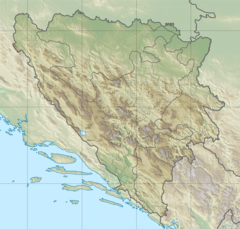Čelebića mosque in Donja Bijenja, or Džaferovića mosque, or Šurkovića mosque, is located in Hadžića, or Ratkovića mahali in the settlement of Donja Bijenja, municipality of Nevesinje, Bosnia and Herzegovina. The village of Bijenja is located at the foot of the Crvanj mountain. It is 12 km from Nevesinje towards Gacko.
| Čelebića Mosque | |
|---|---|
| Religion | |
| Affiliation | Sunni Islam |
| Rite | Hanafi |
| Ownership | Riyasat - Islamic Community of Bosnia and Herzegovina |
| Governing body | Riyasat |
| Patron | Džaferović or Šurković family |
| Status | active |
| Location | |
| Location | Nevesinje, Bosnia and Herzegovina |
| Geographic coordinates | 44°46′02.69″N 17°11′14.44″E / 44.7674139°N 17.1873444°E |
| Architecture | |
| Architect(s) | unknown |
| Type | Mosque |
| Style | Ottoman architecture; vernacular / Herzegovina traditional craftsmanship with low minarets of quadrangular base |
| Founder | Džaferović or Šurković family |
| Completed | late 16th and early 17th c. |
| Demolished | early 1992 |
| Specifications | |
| Dome(s) | no |
| Minaret(s) | 1 |
| Materials | limestone |
| Official name: Čelebić (Džaferović or Šurković) mosque in Donja Bijenja, the historic building | |
| Type | Category I cultural monument |
| Criteria | A; B; C v.; D iv.; E ii., iii., iv., v.; F i., iii.; H i. |
| Designated | 28 June 2005 (Session no. -) |
| Reference no. | 2569 |
| Decision no. | 07.2-2-674/03-5 |
| Listed | List of National Monuments of Bosnia and Herzegovina |
The mosque was demolished in 1992 by Serbs at the beginning of Bosnian War. Today mosque has been restored and inscribed on the List of National Monuments of Bosnia and Herzegovina by KONS, on 28 June 2005.
History and description
editIn the first half of the 18th century, Donja Bijenja was the center of the congregation. There is no information about the time of creation of the Čelebići (Džaferovići or Šurkovići) mosque. It belongs to the type of one-room mosques with sofas, a rectangular base, the external dimensions of which are about 11.50 x 8.70 meters and a stone quadrangular minaret.[1][2][3]
It is known that this type of mosque was built in eastern Herzegovina in the late 16th and early 17th centuries.[4] In addition to the mosque in Bijenja, the minaret with a quadrangular base had: in the Nevesinje area of Perkušić, the mosque in Nevesinje and the mosque in Kruševljani, mosques in the vicinity of Bileća: Avdića mosque in Plana, Hasan-paša Predojevića in Grabovica, mosques in Kljuna, Kružnje and Svinjarina; Telarevića mosque in Bjeljani near Stolac, then the mosque in Glavatičevo near Konjic and the Fatima Kaduna mosque in Mostar. The top of the minaret is made in the form of a tented roof, the slope of which was increased by the last intervention carried out in the 1970s. At the very top of the brick part of the minaret, there were four semi-circular window openings measuring about 40 x 90 cm through which the muezzin would lean his head while reciting the call to prayer. At the very top of the minaret there was an alem.[5]
The mosque was demolished in 1992 by Serbs at the beginning of Bosnian War.[1][2][5]
It was renovated and officially opened in 2006. The main project for the reconstruction of the mosque was prepared and donated by the "Stari grad" project bureau from Mostar. Funds for the reconstruction were mainly provided by donations. The mosque has kept the same dimensions and the same appearance.[1][5]
It was inscribed on the List of National Monuments of Bosnia and Herzegovina by KONS, on 28 June 2005.[2][5]
Bibliography
edit- Hivzija Hasandedić, Mešihat Islamske zajednice, El Kalem, Sarajevo, 1990. -Muslimanska baština u istočnoj Hercegovini
References
edit- ^ a b c "Troimena džamija s dvoja vrata". stav.ba (in Bosnian). 19 January 2024. Retrieved 20 January 2024.
- ^ a b c "Nevesinjske ljepotice: Čelebića i Stara džamija jedinstvenih minareta u obliku sahat-kule". faktor.ba (in Bosnian). 18 June 2017. Retrieved 20 January 2024.
- ^ Hartmuth, Maximilian (2011). Centres and peripheries in Ottoman architecture: rediscovering a Balkan heritage. Ed. Maximilian Hartmuth. Stockholm/Sarajevo: Cultural Heritage without Borders, 2010. Stockholm/Sarajevo. pp. 73–74. Retrieved 20 January 2024.
{{cite book}}: CS1 maint: location missing publisher (link) - ^ "The Ancient Mosques of Bosnia's South". balkaninsight.com (in English and Serbo-Croatian). June 21, 2017. Retrieved 20 January 2024.
- ^ a b c d "Čelebić (Džaferović or Šurković) mosque in Donja Bijenja, the historic building [Čelebića (Džaferovića ili Šurkovića) džamija u Donjoj Bijenoj, historijska građevina]". Commission to preserve national monuments. Retrieved 20 January 2024.
